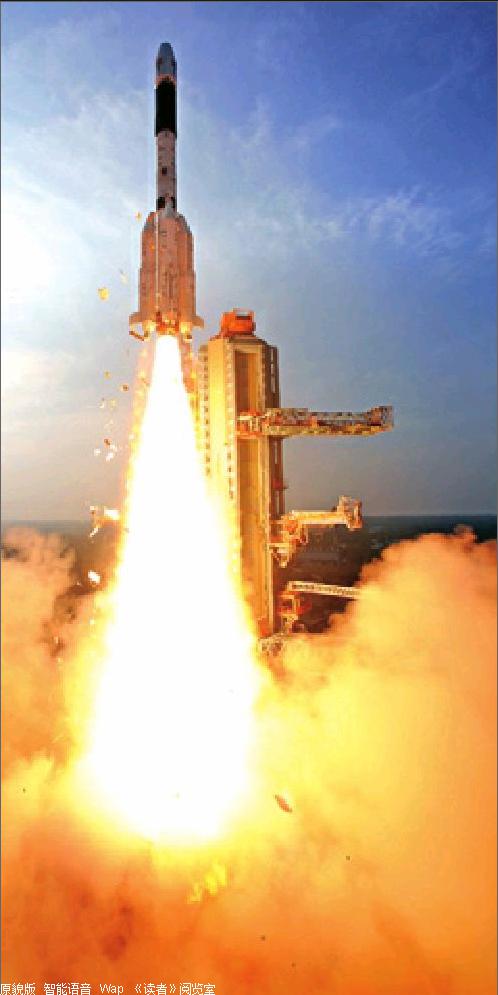India’s Space Race
2014-02-25ByYangKai&QuJing
By+Yang+Kai+&+Qu+Jing

India has become the sixth space player in the world to have mastered the cryogenic propulsion technology after the United States, Russia, Europe, Japan and China. On January 5, at the Indian Space Research Organization (ISRO)s Satish Dhawan Space Center in the eastern coastal city of Sriharikota, a satellite launch vehicle dubbed GSLV (geosynchronous satellite launch vehicle)-MK2 rocketed into the sky. Seventeen minutes later, the rocket successfully placed a satellite into its orbit.
This was the second launch of the GSLVMK2 rocket. The models first launch failed in April 2010 due to the breakdown of its cryogenic upper stage that India independently developed. Both the rocket and its attached satellite were destroyed as the rocket exploded and fell into the Indian Ocean.
The GSAT-14, the satellite that the rocket sent to the space, is the 23rd geosynchronous communication satellite that the ISRO has developed. This satellite, weighing 1.98 tons, is expected to strengthen the countrys communication capabilities and provide a platform for new testing.
The rocket is a three-stage, 49.13-meter-long launcher. This type of rocket can be equipped with either a 7.8-meter-long aluminum alloy payload fairing 3.4 meters in diameter or an 8.7-meter-long carbon fiber reinforced composite fairing 4 meters in diameter. In the previous failed launch, it adopted a large fairing capable of launching a 2.22-ton payload. This time, a smaller aluminum alloy fairing was used to avoid risks.
Rocket science
Indias launch vehicles on active duty include the GSLV and the polar satellite launch vehicle(PSLV). The PSLV is four-stage launcher with a carrying capacity of 1.3 tons. It has the abil- ity to carry more than one satellite per launch and has successfully launched lunar and Mars probes. By the end of 2013, the PSLV had been launched 25 times, hitting a success rate of 92 percent with its 23 completed missions.
Many Indian satellites could not be launched by the PSLV due to its limited carrying capability. India thus began developing the GSLV, which has a greater carrying capacity than the PSLV. The GSLV is designed to send a 2-ton communication satellite into a geostationary transfer orbit, as well as implementing low earth orbit launch missions. It has three configurations: the three-stage MK1 and MK2, and the two-stage MK3. The GSLV has been launched eight times since April 2001, only three of which succeeded. In its recent launch of the MK2, the ISRO adopted its independently developed cryogenic upper stage technology, and improved the vehicles control system.endprint
India has begun development work on the MK3 carrier rocket, which will have an even greater carrying capacity to meet the countrys growing demands. This project was approved in the 2002-03 fiscal year, but the first launch of the MK3 has been postponed to April 2014 due to snags in the cryogenic upper stage research phase. The MK3s geostationary transfer orbit capacity is expected to reach 4 tons. It is also expected to be able to carry out multi-orbital launches. This project can fulfill Indias demands of launching large satellites and manned missions. Furthermore, it represents Indias efforts to join in the competition of the international commercial launching market.
India started researching cryogenic engine technology after it began working on the GSLV project in the 1980s. As Western countries including the United States declined to transfer the technology to India, the latter reached agreements with the Soviet Union in January 1991 and purchased five cryogenic engines and related technology from Moscow.
Russia signed an agreement that prohibited transferring cryogenic engine technology to India in April 1992 following U.S. pressure. But Russia never completely ceased transferring technology to India. In July 1993, Moscow sold another two cryogenic engines to India. In the meantime, India researched cryogenic engine technology independently by devising a cryogenic upper stage plan and establishing a liquid propulsion system center in Tamil Nadu. Following 20 years of efforts plus learning from Russias cryogenic upper stage technology, India finally completed a test run of its independently developed cryogenic engine in December 2008, and succeeded in developing the crucial and complicated cryogenic engine technology.
The first test flight of the GSLV-MK2 rocket, which adopted this newly developed technology, failed due to a fuel turbo pump breakdown in 2010. India improved its propellant turbo pump and other parts of the cryogenic upper stage after analyzing results of the abortive launch. It conducted a ground test of the upgraded cryogenic engine in May 2012. The engine withstood a 200-second test run at the ISROs liquid propulsion center. The organization conducted high-altitude tests of its cryogenic engine in March and May 2013, verifying the engines stability.
Project India
The successful launch in January proved the performance of Indias cryogenic technology, cementing the further development of large-scale rockets. It also provided a technological guarantee for the coming MK3. Indias future deepspace exploration and manned space missions are off to a promising start.endprint
The independent development of the cryogenic engine technology can help India wean itself off of foreign dependence in the field, while greatly reducing launch costs and increasing the countrys competitiveness in the international commercial launching market.
The ISRO declared that the successful launch diminished Indias reliance on foreign commercial launchers, like Europes Arianne 5, paving the way for decreased launching expenses. Moreover, with this sophisticated technology, the country can launch more satellites, increase its space communication ability, and earn more profits. India usually has to pay $85 million-$90 million to launch a 3.5-ton satellite by using foreign commercial carrier rockets. The recent launch cost only $35.45 million.
India has been making efforts to enter the international commercial satellitelaunching market. In 2007, it became the fifth country with the ability to launch commercial satellites after launching an Italian satellite with a PSLV rocket. But it had been able to launch only low earth orbit satellites due to its low carrying ability. Indias development plan has been limited by its reliance on Russias cryogenic engine, which comes at a cost of $18 million for each mission. With its indigenous cryogenic propulsion technology, India can develop large carrier rockets independently, which puts it in a position to compete in the international commercial launching market.
The GSLV-MK2 will serve a transitional role in Indias rocket development program. According to Indias five-year plan for 2012-17, the PSLV will have 17 flight missions, compared to just six for the GLSV-MK2, including test flight missions. Indias plan requires the country to develop carrier rockets with a bigger carrying capacity for its satellites and future deep-space exploration missions. Therefore, the MK2 is only a transitional model to test Indias cryogenic upper stage technology and to lay a solid foundation for future research on the MK3.
India has put forward systematic goals for its national space development in recent years. It has confirmed its 12th five-year plan of space development and its prospective outlook for 2025. Its ambitious space plan calls for further perfecting infrastructure for space exploration and promoting independent spaceflight capabilities.
Currently, India has mastered technology for small- and medium-scale rockets that rely on mature solid propulsion technology. But large-scale carrier rockets require more advanced cryogenic propulsion technology. Cryogenic upper stage research is an important focus of Indias 12th five-year plan. The recent successful launch of the GLSV-MK2 verified the Indian cryogenic technology, and raised the curtain for future technological developments such as deep-space exploration, production of large launch vehicles and manned space flight.endprint
